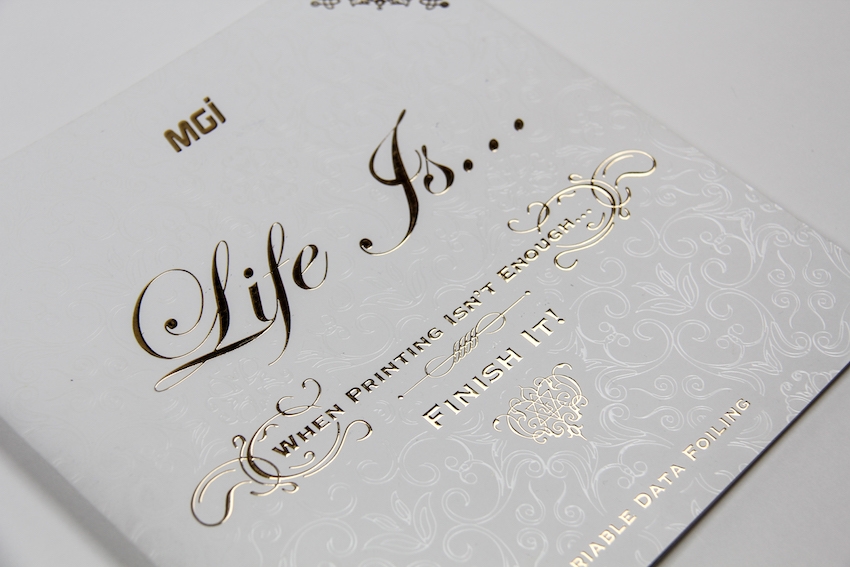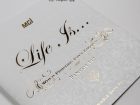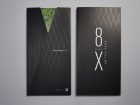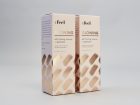
Application
News
Postpress designs: Capitalizing on print-enhancement technologies
September 21, 2018 By Victoria Gaitskell
 An example of foil decoration using Print Panther’s MGI JETvarnish 3DS and iFOIL S. Using MGI’s inkjet and hot foil stamping processes, the system provides digital spot UV coating in plain 2D and 3D formats, plus embossed and foil textured effects. Photo: Print Panther
An example of foil decoration using Print Panther’s MGI JETvarnish 3DS and iFOIL S. Using MGI’s inkjet and hot foil stamping processes, the system provides digital spot UV coating in plain 2D and 3D formats, plus embossed and foil textured effects. Photo: Print PantherWith an abundance of new print-finishing technologies flooding the market, printers may wonder how to separate the glitzy effects from bona fide business opportunities. To aid in this dilemma, PrintAction turned to an assortment of business leaders for their thoughts on how to leverage new finishing technologies.
New opportunities
“A common theme our clients express is that print enhancements help make a printed product more ‘permanent,’” says Richard Kouwenhoven, President and COO at Hemlock Printers in Burnaby, B.C.
“A strength of print as a medium and how it differentiates itself from digital properties in the marketplace is that it produces an actual physical object that feels neat to hold and is special to the recipient. The renewed energy around using print to do something special is quite exciting for the industry.”
Jeff Taylor, Senior Vice President of Manufacturing and Operations at Hemlock, says in the 1980s and 1990s, it was mandatory for companies to summarize their business successes in a printed annual report. Today Hemlock has seen a resurgence with large companies using print to reinforce their brand, celebrate special events, and orient new hires. For example, fast growing tech companies are now communicating their culture and values to personnel through recurring magazines and perfect-bound books. Hemlock’s most popular finishing options include UV and other specialty coating treatments and a variety of decorative techniques on coloured substrates, especially for covers. “We research different stocks to add tactile interest and different embellishments to make the product stand out, such as metallic, glitter or holographic foils and coatings – which can be applied overall or heavily in what we call a ‘high build,’ or only in certain spots to add a tactile element, such as grit. Some of our more elaborate projects might combine a dozen of these different methods. They give the piece a higher perceived value,” Kouwenhoven explains.
Hemlock says it has been focused on developing new perfect-bound products since its 2017 purchase of a Muller Martini Allegro Perfect Binder. “We use perfect binding as a way to enhance the look and quality of the final piece and make it unique by adding functions such as pockets, flaps, insets and overhanging covers,” Taylor says. “After doing R&D on finishing equipment and trends, we thought we needed this state-of-the-art equipment for our customers. We can’t figure out why more of our peers in North America aren’t investing in finishing equipment of the same calibre.”
Finishing versus decorating
Jeff Peterson, Executive Director of the Foil & Specialty Effects Association (FSEA) in Topeka, Kansas, distinguishes between more utilitarian as opposed to more decorative postpress operations. “One of the things I’d like to do is create a better definition of some of the terms used in postpress. I hear the term ‘print finishing’ a lot, but I define it as any type of process that could be used after printing. I prefer to use the terms ‘print decorating’ or ‘print embellishments’ for the more decorative versus the more production-oriented bindery operations.”
Peterson adds that in practice the line between production and decorative finishing processes is still blurred. For example, in lamination, if the film you are using has a leather or holographic pattern, then you are decorating the printed sheet as well as protecting it.
At Print 18, Peterson will lead a presentation on the foil-decorating methods available today, how they are performed, and which applications are best suited to each method. “There are new metallic foil-decorating methods on the market today that weren’t available just several years ago,” he says.
First photo: The 8X covers have a flood dull coating with clear foil and embossing, with folders that have a delustered laminate and are clear foiled and embossed. Second photo: The Feel packaging has a soft-touch coating applied and is foiled stamped with rose-gold foil. Photos: hemlock printers
Know thy customers
Nikos Kallas, President of Metropolitan Fine Printers Inc. (MET) in Vancouver, B.C., believes the days of ‘buy it and they will come’ are over. “Your clients aren’t going to spend double the money on a new finishing feature just because it looks cool,” he says. “The key is helping your clients be more successful. Everyone needs to justify their investment in terms of ‘What’s it going to do for me?’ They are interested in new technology that can help them make more sales or build better brand awareness, all within a reasonable cost.”
Kallas recalls a job MET did for a telecom company to sell NFL ticket subscriptions. “It [was] a booklet with a cover made of artificial turf. It was targeted to only 1,000 recipients and very expensive to produce. Although the client reported a high return from the project, they didn’t want to repeat the financial risk by printing it again.
“A lot of the decorative specialty stuff is meant for short run, not long run.”
He emphasizes the need to tailor the offering to the individual client. For example, a client selling toilet paper probably doesn’t need raised UV on the packaging, but may want to try a new synthetic, environmentally friendly wrapping to improve sales. In other cases, “beautiful graphics that pop off a sheet will be worth the investment, if the resulting product makes the consumer spend five more seconds looking at the piece. If a client is printing a black-and-white catalogue, you might convince them to go colour and add PMS [Pantone Matching System] Metallic, spot UV and raised foil.”
Meanwhile, Taylor says Hemlock only invests in new technology if the team is 100-percent convinced they have the volume or can grow the volume of business to support it. The firm also uses an annual advisory group to gain market insight and feedback. “We ask them how we can enhance our services and their environmental standards…and what direction technologically they’d like to see us take, which helps us steer away from a shiny object that might sound exciting but our customers will not support,” he says.
Research before buying
For commercial printers considering the acquisition of new finishing technology, Peterson suggests partnering with a finishing company first that is already running that technology to see the types of potential business it attracts. “Eventually the printer may get to a level where bringing the technology in-house makes sense…or decide the partnership is more cost-effective and it makes more sense to [keep] doing what they do best.”
Before purchasing Canada’s first MGI JETvarnish 3DS and iFOIL S in 2016, Christine Yardley, now President of Print Panther of Oakville, Ont., travelled to Chicago, Ill., to witness it up and running at another printing company. She says the trip helped her gain much greater clarity in terms of how the equipment would physically fit into Print Panther’s own space and the types of jobs it is capable of doing.
Following the acquisition, it took Yardley’s team between six to nine months to fine-tune their handling of software, graphic design and materials to make the new equipment work best for their jobs. “Now we’re very fussy about the print work we take in from other printers,” she says. “I call it ‘preferred trade’ because we understand our sweet spot and stick to what we’re good at.”
Continuous investment
In Mississauga, Ont., C.J. Graphics’ 240,000-square-foot facility houses North America’s first Scodix Ultra Pro with Foil. Installed in 2015, the system produces foil with run lengths from one up to 10,000, designed to enhance packaging, brochures, business cards, invitations, book covers and other products.
In 2015, the company also acquired Canada’s first Highcon Euclid II+ system, described as the first fully digital cutting and creasing machine for converting paper, labels, folding carton and micro-flute. The Euclid, supporting both conventional and digital press production, incorporates Highcon’s patented Digital Adhesive Rule Technology (DART) and polymers to produce creases, as well as high-speed laser optics to cut a range of substrates.
“It takes a while to build up the market for it, there is no question, but I can tell you we have two major accounts – one out of the U.S. and one out of the U.K. – because of those machines,” said Jay Mandarino, C.J. Graphics President and CEO, in an April 2018 interview with PrintAction. “We are very sales driven and we have always invested in technology and it has made us successful. You have to find new stuff all of the time.”
The facility’s advanced digital finishing department also features a wide range of off-line coating devices, and lamination, die-cutting, foil stamping and blind embossing equipment and services.
Growth potential
The market for decorative finishing technology and processes will continue to grow, Peterson predicts. “There are more alternatives out there now to achieve a decorative metallic look or UV coating, so whatever the application, you can choose the right way to go. Printers are looking for ways to separate themselves from competitors [by] creating eye-catching graphics. Labels and cartons are going to continue to be important to brand managers. I think all these factors will help keep metallic foils and coatings relevant for years to come.”
This feature was originally published in the September 2018 issue of PrintAction, now available online.
Print this page


